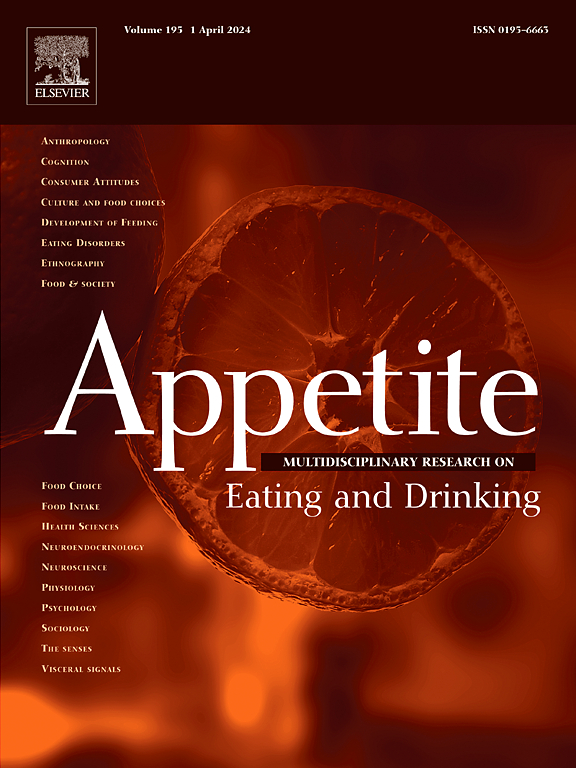了解家庭食物不安全和饮食质量之间的关系:心理困扰、食物选择动机和膳食模式的作用
IF 4.6
2区 医学
Q1 BEHAVIORAL SCIENCES
引用次数: 0
摘要
家庭粮食不安全——缺乏获得安全、营养和足以维持正常生长的食物的可靠途径——与身心不健康有关。在英国和世界上许多国家,粮食不安全因生活费用危机而加剧,是一个主要的公共卫生问题。为了确定潜在的干预点,重要的是要了解粮食不安全如何与个人层面的因素相关联,包括对粮食的行为和动机。因此,本研究在英国成年人样本(N = 594,平均年龄= 40.6岁,96%为女性)中调查了家庭食品不安全(HHFI)、心理困扰、食物选择动机和膳食模式行为之间的关系。使用问卷对关键变量进行量化,并使用结构方程模型来确定它们之间的关联。HHFI与基于价格的较高食物选择动机直接相关,但与其他食物选择动机不直接相关。HHFI通过价格动机与较差的饮食质量间接相关。HHFI与饮食质量之间也存在一系列显著的间接关联,包括痛苦和食物选择动机。具体来说,HHFI与更大的痛苦有关,而痛苦又与更高的便利动机和更低的健康动机有关,而后者又与更差的饮食质量有关。探索性分析表明,HHFI与较低的用餐频率直接相关,而这反过来又与较差的饮食质量相关。研究结果表明,一般心理困扰的经历、某些食物选择动机和用餐频率可能在食物不安全和饮食质量之间的关系中发挥作用。本文章由计算机程序翻译,如有差异,请以英文原文为准。
Understanding the association between household food insecurity and diet quality: The role of psychological distress, food choice motives and meal patterning
Household food insecurity – a lack of reliable access to food that is safe, nutritious, and sufficient for normal growth – is associated with physical and mental ill-health. In the UK and many countries worldwide, food insecurity has been exacerbated by the cost-of-living crisis and is a major public health concern. To identify potential points of intervention, it is important to understand how food insecurity is associated with individual-level factors, including behaviours and motivations towards food. This study therefore examined the associations between household food insecurity (HHFI), psychological distress, motives underlying food choices and meal patterning behaviours in a sample of UK adults (N = 594, mean age = 40.6 years, 96 % female). Key variables were quantified using questionnaires and structural equation modelling was used to determine the associations between them. HHFI was directly associated with higher food choice motives based on price, but not directly with other food choice motives. HHFI was indirectly associated with poorer diet quality via price motives. There were also significant serial indirect associations between HHFI and diet quality via distress and food choice motives. Specifically, HHFI was associated with greater distress, which in turn was associated with higher convenience motives and lower health motives, which were then both associated with poorer diet quality. Exploratory analyses indicated that HHFI was directly associated with lower meal frequency, and this in turn was associated with poorer diet quality. Findings demonstrate how experiences of general psychological distress, certain food choice motives, and meal frequency may play a role in the relationship between food insecurity and diet quality.
求助全文
通过发布文献求助,成功后即可免费获取论文全文。
去求助
来源期刊

Appetite
医学-行为科学
CiteScore
9.10
自引率
11.10%
发文量
566
审稿时长
13.4 weeks
期刊介绍:
Appetite is an international research journal specializing in cultural, social, psychological, sensory and physiological influences on the selection and intake of foods and drinks. It covers normal and disordered eating and drinking and welcomes studies of both human and non-human animal behaviour toward food. Appetite publishes research reports, reviews and commentaries. Thematic special issues appear regularly. From time to time the journal carries abstracts from professional meetings. Submissions to Appetite are expected to be based primarily on observations directly related to the selection and intake of foods and drinks; papers that are primarily focused on topics such as nutrition or obesity will not be considered unless they specifically make a novel scientific contribution to the understanding of appetite in line with the journal's aims and scope.
 求助内容:
求助内容: 应助结果提醒方式:
应助结果提醒方式:


